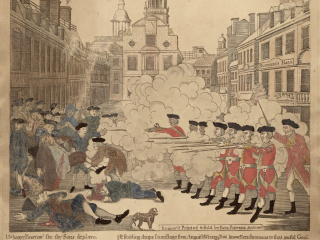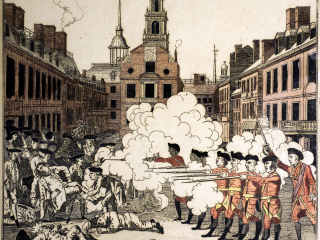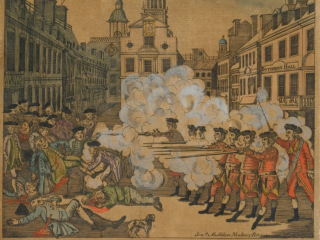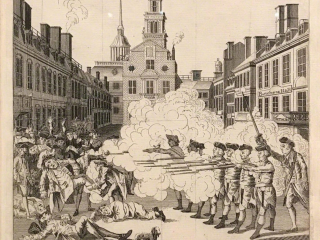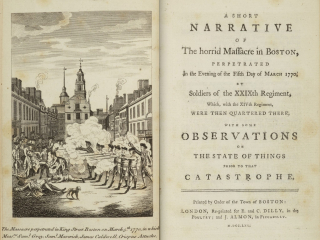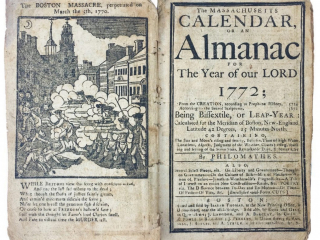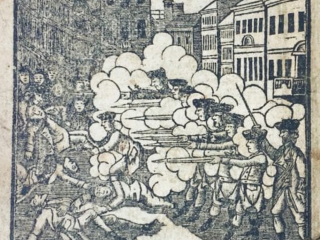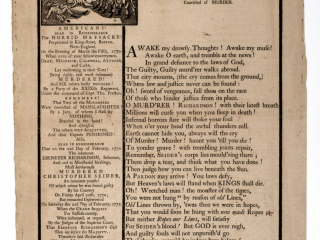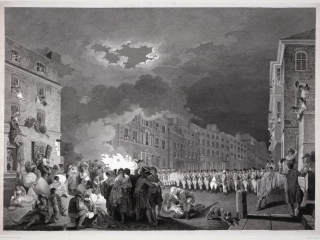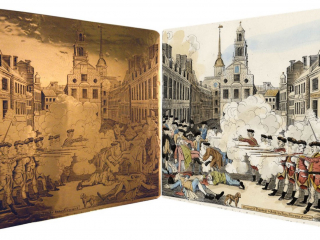Imagining the Boston Massacre asks students to consider images of the one of the most important and controversial events of the Revolutionary era. This lesson invites students to examine and interpret depictions of the Boston Massacre—the deadly confrontation between Bostonians and British troops on the evening of March 5, 1770—by examining contemporary engravings of the event by Henry Pelham and Paul Revere of Boston and Jonathan Mulliken of Newburyport, Massachusetts, as well as later versions of the same image. The goals of the lesson are for students to understand the importance contemporaries attached to the event, how the event reflected and shaped colonial resistance to British authority, and how powerful images can focus popular attention and shape political views.
Like the other lessons in this series, Imagining the Boston Massacre asks students to go beyond obvious questions about the literal accuracy of images to consider them as valuable sources for understanding how artists and their audiences understood the events depicted.
Suggested Grade Level
Middle and High School
Recommended Time
Two +/- fifty minute class periods
Objectives and Essential Questions
At the conclusion of the lesson, students will:
- understand how the artists and their audiences understood the events of March 5, 1770;
- understand how the Boston Massacre contributed to the growth of Revolutionary sentiment by stirring popular outrage at the British army and the British ministry;
- develop skills needed to analyze and interpret visual images through close comparison of similar, but not identical, images; and
- understand how the publication of dramatic images reflects and shapes popular opinion.
Materials and Resources
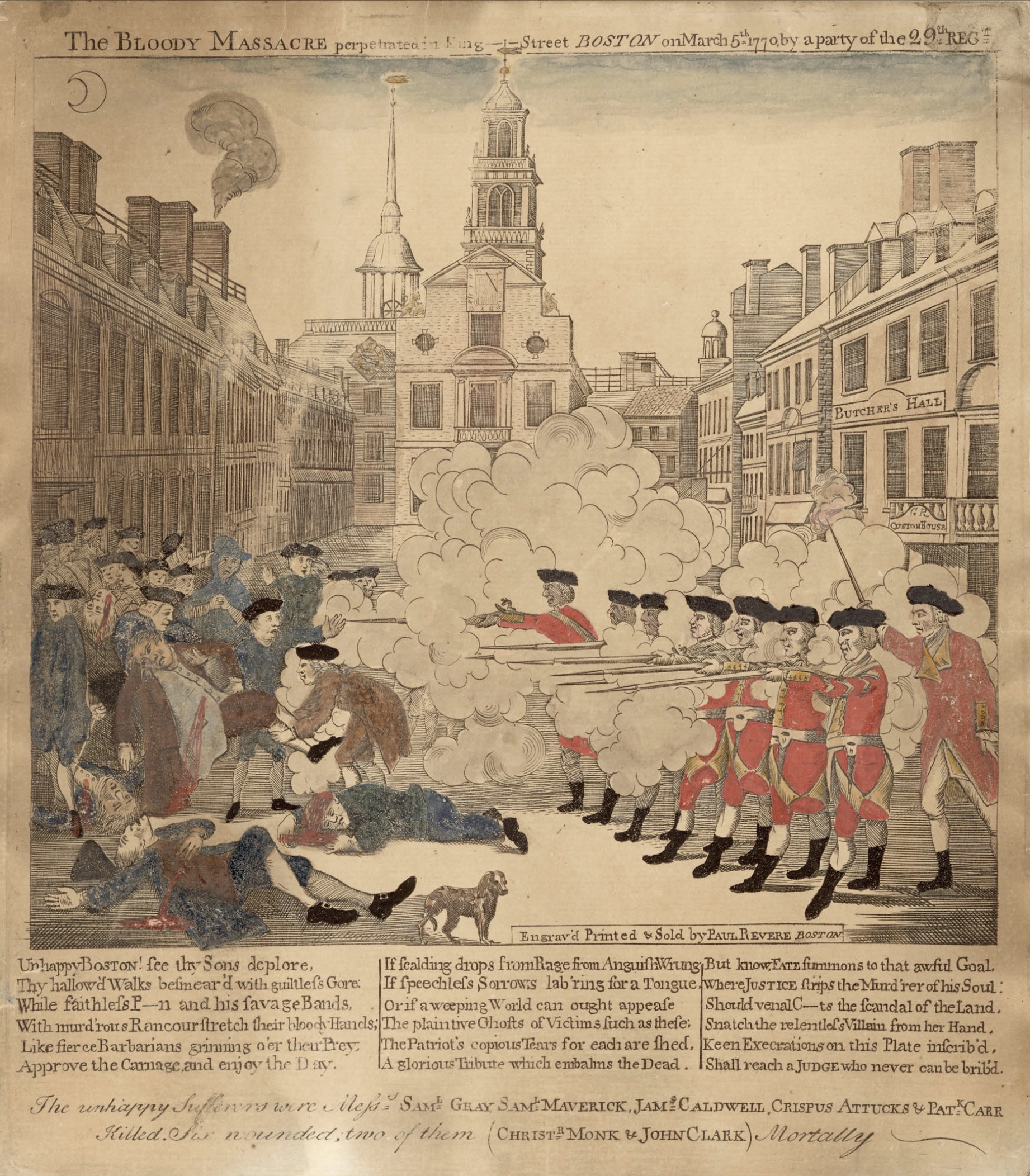
Images for the Lesson
- The Bloody Massacre, engraved by Paul Revere, Boston, [1770], Massachusetts Historical Society
- The Fruits of Arbitrary Power, [engraved by Henry Pelham, Boston, 1770], American Antiquarian Society
- The Bloody Massacre, engraved by Jonathan Mulliken, Newburyport, Mass., [1770], Harvard University Libraries
Images for the Assessment
- The Fruits of Arbitrary Power, engraver unknown, London: W[illiam] Bingley, [1770], private collection
- The Massacre perpetrated in King Street Boston, frontispiece of A Narrative of The horrid Massacre in Boston, London: W[illiam] Bingley, 1770, private collection
Images for the Extension
- The Boston Massacre, wood engraving [by Paul Revere], frontispiece to The Massachusetts Calendar, or an Almanac for The Year of our Lord 1772, Boston: printed by Isaiah Thomas, [1771], private collection
- A Monumental Inscription on the Fifth of March. Together with a few Lines On the Enlargement of Ebenezer Richardson, Convicted of Murder [Boston: Isaiah Thomas, 1772], American Antiquarian Society
Background Knowledge
This lesson presumes that students have already learned the basic story of the the Boston Massacre, an incident on the night of March 5, 1770, in which a party of the British troops occupying Boston was confronted by a large and angry crowd of civilians outside the customs house on King Street.
Relations between the army and Bostonians had been difficult since the troops arrived in 1768, but they grew very bad during the winter of 1769-1770. Insults were exchanged daily, and fights between soldiers and civilians were frequent. Then on February 22, a customs official named Ebenezer Richardson, angered by a crowd of boys and young men throwing snowballs, rocks, and dirt clods at his house, fired a gun loaded with bird shot at them from an upstairs window, hitting a young man named Samuel Gore and a boy named Christopher Seider. Christopher died hours later. Hundreds of Bostonians joined his funeral procession, held on February 26. Relations between Bostonians and the army grew worse in the days thereafter.
The confrontation that led to the shootings on March 5 began when a sentry at the customs house hit an apprentice, with whom he had been exchanging insults, in the head with his musket. A crowd gathered in support of the apprentice, and the sentry called for help. Capt. Thomas Preston appeared with six armed soldiers and shouted at the crowd to go home. Instead of obeying Preston, people began throwing sticks, snowballs and chunks of ice at the soldiers. One hit Private Hugh Montgomery and knocked him down. Montgomery got to his feet, picked up his gun and fired it into the crowd. Within a few moments other soldiers began firing. Eleven civilians were shot. Five were killed on the scene and two others died within a few days.
The angry crowd moved back into the nearby streets and many more armed soldiers arrived to support Preston and his men. The shooting stopped. Governor Thomas Hutchinson came to the scene and spoke to the crowd from the balcony of the nearby State House. He promised there would be an investigation and asked the people to go home. The sullen crowd broke up.
The next day, the Boston Town Meeting demanded that the governor order the troops out of the city. In order to avoid further loss of life, the British commander withdrew all his troops from the city and moved them to Fort William on Castle Island in Boston Harbor. The town meeting also launched its own investigation of the tragedy, appointing three leading citizens to interview witnesses and prepare an account of the event. Preston and several of the soldiers were arrested and charged with murder. Within a few days, public funerals were held for the five victims.
News of the Boston Massacre spread quickly and angered colonists from New Hampshire to Georgia. Samuel Adams and other patriot leaders made sure that published accounts of the event made it appear that the civilians did nothing to provoke the soldiers. A pamphlet published by the Boston town meeting titled A Short Narrative of the horrid Massacre described the shooting as a vicious attack on peaceful Bostonians. In response, loyalists published a pamphlet titled A Fair Account of the Late Unhappy Disturbance in Boston. It described the shootings as the result of an ambush planned by street gangs.
Boston lawyers who were sympathetic to the British soldiers refused to defend Preston and his men in court. They worried that angry Bostonians would retaliate against them. Finally John Adams, a cousin of Samuel Adams, agreed to serve as their lawyer. He believed everyone deserves a fair trial, including the services of a lawyer to argue on their behalf. Preston was found not guilty because the jury agreed he did not order his men to fire and that he tried to stop them.
Hugh Montgomery, the first soldier who fired into the crowd, and another soldier who fired were found guilty. The jury agreed that the two soldiers had been afraid they might be killed and so were not guilty of murder. They were convicted of the lesser charge of manslaughter. They were released after having their thumbs branded. This was a sign that they had been found guilty of manslaughter and that if they were found guilty of it a second time, they would be executed.
The news that British soldiers had fired on colonists armed only with snowballs and sticks shook the loyalty of many colonists to King George III and his government. They became more convinced than ever that the British government did not care about them and was working to take away their freedom. John Adams later wrote that the “foundation of American independence was laid” on the evening of March 5, 1770, in the streets of Boston.
Sequence and Procedure
Step 1: Share the Story of the Boston Massacre Prints
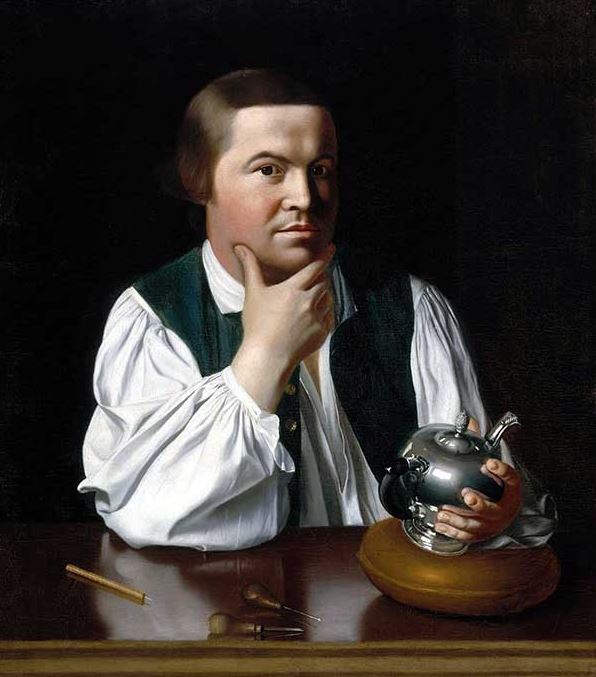
John Singleton Copley painted this portrait of silversmith Paul Revere in 1768, two years before the Boston Massacre (Museum of Fine Arts, Boston).
Prints of what quickly became known as the Boston Massacre were published in the weeks after the tragedy. The most common, but flawed, interpretation of these prints is that they were patriot propaganda that deliberately misrepresented the tragedy to encourage popular outrage and anger at the British troops and the government that had sent them to Boston. This interpretation—which is often presented to students as indisputable fact—misses the true importance of these prints. The prints reflect the reaction of the artists and their American audiences to the tragedy as much as they shaped those reactions.
By far the best known of the prints, then and now, was engraved by Paul Revere (1735-1818), the Boston silversmith immortalized in the middle of the nineteenth century by poet Henry Wadsworth Longfellow for his daring ride to call out the militia on the night before the Battles of Lexington and Concord. Paul Revere’s engraving of the Boston Massacre has been published and republished in history books for two hundred years and is the best known contemporary image of an event in the American Revolution.
It may surprise students to learn that the image was not created by Paul Revere. It was the work of a young Boston artist named Henry Pelham (1749-1806) who drew a depiction of the confrontation between the British soldiers and the crowd with the intention of engraving and selling it to the public. Pelham was the younger half-brother of John Singleton Copley, a gifted Boston portrait painter. Copley, who was ten years older than Pelham, apparently taught his half-brother how to draw and paint.
Pelham showed Revere the engraved plate he had prepared and seems to have left it in Revere’s custody for some reason. Revere knew how to cut designs on metal, and had taught himself how to cut engraving plates, which he had been doing as a sideline for several years. Pelham had little experience with engraving and may have gone to Revere for technical advice or help.
Without Pelham’s permission, Revere quickly engraved his own version of Pelham’s plate, had prints made from it, and offered them for sale to the public on March 26, 1770, just three weeks after the event. Pelham was furious with Revere and wrote an angry letter to him on March 29:
Sir,
When I heard that you was cutting a plate of the late Murder, I thought it impossible as I knew you was not capable of doing it unless you coppied it from mine and I thought I had intrusted it in the hands of a person who had more regard to the dictates of Honour and Justice than to take the undue advantage you have done of the confidence and Trust I reposed in you. But I find I was mistaken and after being at the great Trouble and Expense of making a design and paying for paper, printing &c. find myself in the most ungenerous Manner deprived not only of any proposed Advantage but even of the expense I have been at, as truly as if you had plundered me on the highway. If you are insensible of the Dishonour you have brought on yourself by this Act, the World will not be so. However, I leave you to reflect upon and consider one of the most dishonourable Actions you could well be guilty of.
H. Pelham
P.S. I send by the Bearer the prints I borrowed of you. My Mother desired you would send the hinges and part of the press, that you had from her.
Students may ask whether Pelham sued Revere. He did not. Modern American law protects artists by giving them exclusive right, or copyright, to their work, but in the eighteenth century works of art were not protected by copyright. Any artist or printer could copy another person’s work and sell his copies without owing anything to the creator. This is what Paul Revere did. Pelham complained that Revere had violated his trust but there was nothing he could do about it.
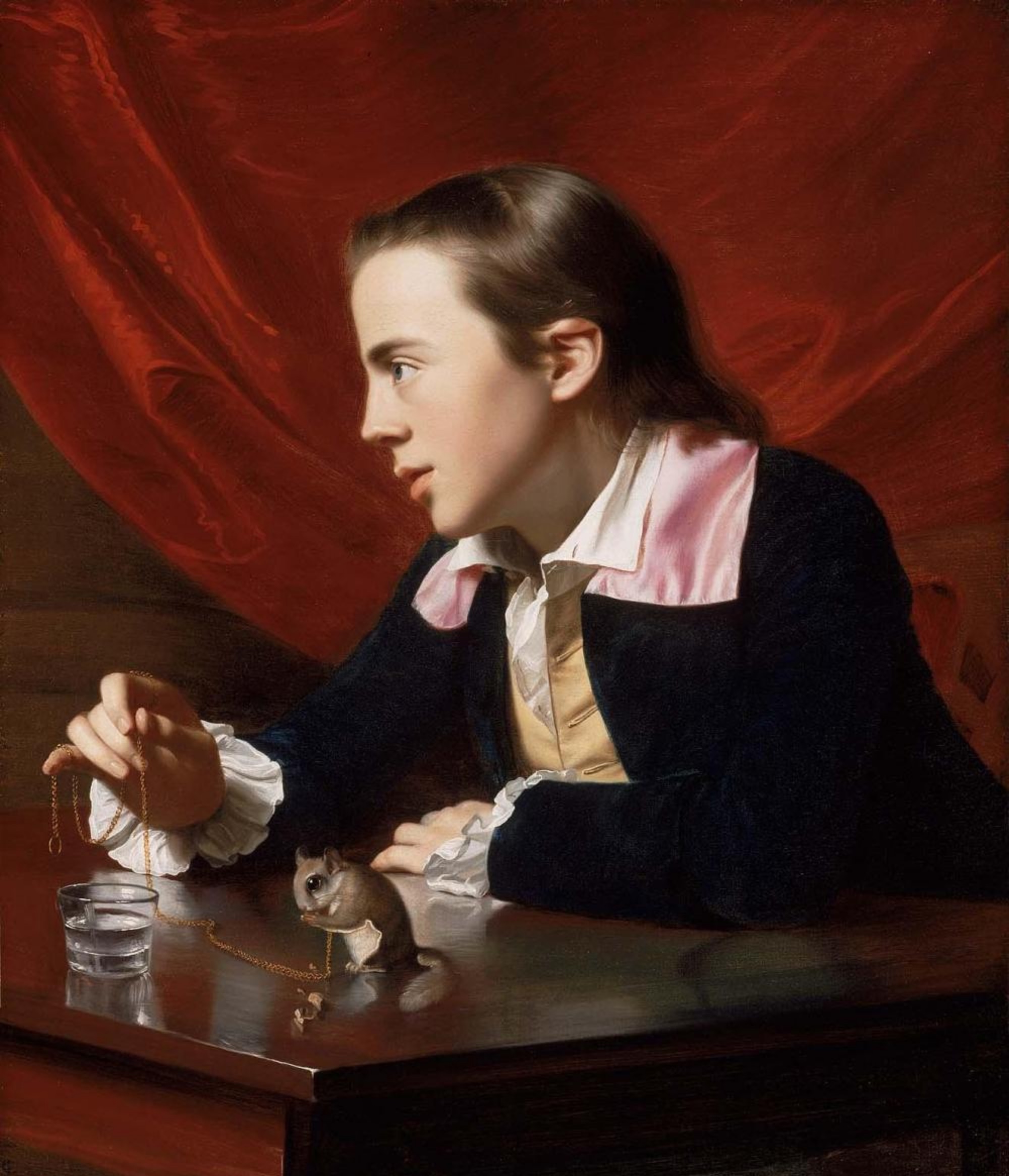
John Singleton Copley painted this extraordinary portrait of his half-brother, Henry Pelham, in 1766. Copley titled it Boy with a Flying Squirrel (Museum of Fine Arts, Boston).
Pelham paid a craftsman to print 575 copies of his print and ran an ad in the Boston Evening Post on April 2, 1770, offering it for sale. Revere was better known as an engraver and had a week’s head start on the younger man. By the time Pelham’s print went on sale, Revere’s version was all over Boston and copies were circulating in nearby towns.
Pelham and Revere worked quickly so they could take advantage of public outrage over the killings to fuel sales of their prints. Demand was so great that another amateur engraver rushed to join them. In Newburyport, a town forty mile north of Boston, Jonathan Mulliken (1746-1782), copied Revere’s engraving and sold his own version of the print. A clock and watch maker, Mulliken was used to working with sheet metal and was experienced at engraving letters and numbers, so he had the basic skills to copy Revere’s engraving. Like Pelham, he probably paid someone else to print copies from his engraving plate.
Interest in the print was not limited to New England. On April 1, the Boston Town Meeting dispatched a hired sloop to England, carrying copies of the report prepared by committee appointed to investigate the killings and copies of the Pelham and Revere prints. On May 5—just two months after the killings in Boston—a British edition of A Short Narrative of The horrid Massacre was offered for sale in London. It was published by William Bingley (1738-1799), a radical printer associated with John Wilkes, a celebrated advocate of liberty and critic of the British ministry.
Bingley included an engraving of the killings as a frontispiece—that is, an illustration facing the title page—with the title The Massacre perpetrated in King Street Boston. Bingley also offered a separate engraving for six pence titled The Fruits of Arbitrary Power; or the Bloody Massacre, Perpetrated in King-street, Boston. Thus, within two months of the killings in Boston, Henry Pelham’s depiction of the event was circulating in Britain as well as America.
The image stayed in circulation for years. It appeared on broadsides—a kind of small poster intended to be tacked to the doors and walls of businesses and public buildings—and in simple, reduced form in almanacs and other publications. The image was so popular because it reflected ideas the colonists (and the English radicals who bought copies of it made by William Bingley) had about the presence of the British army in Boston and about misconduct of the British ministry in its relationship with Britain’s American colonies.
Step 2: Lead a Close Examination of the Boston Massacre Prints
For this step exhibit the Pelham and Revere prints side-by-side to facilitate a close examination and comparison by the class. An important goal of this exercise is to train students to look very carefully at documents and consider details. Unless encouraged to look closely, most people will glance quickly at this image, recognize it as a depiction of soldiers shooting civilians at close range on a city street, and catch the title of Revere’s print, The Bloody Massacre. They will notice the poem at the bottom but won’t read it. They will recognize that the artist intended to present the soldiers as aggressors and the civilians as victims. They may suspect—or in a classroom setting a teacher may say—that the depiction is not altogether accurate and that the artist deliberately misrepresented the scene to arouse anger and hatred of the soldiers (both assertions that ought to be defended rather than announced as fact). Consideration of the print will focus on what’s accurate—what about the depiction is literally correct, and what is inaccurate or even distorted. The teacher may even suggest that the print is an example of propaganda—that is, a deliberate misrepresentation intended to inflame viewers and manipulate their emotions for political ends. This is the most common interpretation of the Revere print, but it is a very superficial one.
The aim in this lesson is different. We want students to avoid hasty conclusions and to consider the two prints in detail to see what they can tell us about the patriot cause as it was transformed from resistance to British policy and action to rebellion. The event depicted in these prints, regardless of their literal accuracy, was a major milestone in that transformation. It was the first time the king’s troops killed colonial civilians. That was a major, traumatic event in the degenerating relationship between the British government and its American subjects. If we want to understand how the American Revolution happened, we need to study the evidence carefully and try to understand what it tells us. When we do so, we realize that the Pelham and Revere prints and the various versions of them reflect a great deal about how colonists, among whom Henry Pelham and Paul Revere were simply artists and communicators, thought about the event.
Comparing the two, very similar prints helps us see the details. The Pelham and Revere prints are not identical. A side-side examination reveals the similarities and the differences. Recognizing the differences leads naturally to questions about why they are different. Considering why draws us into the mental universe of the colonists, where we can begin to understand what they thought and thus why they acted as they did. It draws us into true historical study and discourages superficial conclusions.
Here are the most obvious similarities:
-
- Both prints consist of a title at the top, an image in the middle, and text at the bottom.
- The depiction of the buildings is essentially the same in the two prints.
- Both prints depict seven British soldiers firing while an officer stands behind them with his sword raised. Note that we know from witnesses that Preston came to Private White’s help with six soldiers, so the number of British soldiers depicted is based in fact.
- The soldiers are firing into a crowd of twenty Bostonians. Five of the people in the crowd—presumably the five victims who died at the scene—are shown bleeding from gunshot wounds. Three lie on the ground and two are being helped by others.
- A woman is depicted in the middle of the crowd—she is depicted more clearly in the Revere version.
- A man with his hand raised, apparently appealing to the soldiers to stop shooting, is in the middle of the group.
- Incongruously, a little dog stands in the foreground, appearing undisturbed by the gunfire and chaos.
- Neither print is very skillfully executed. They’re primitive examples of the engravers art, created by amateurs. To illustrate this point, compare the two prints to The Riot in Broad Street on June 7, 1780, engraved by James Heath and published in London in 1790. This is not a depiction of the Boston Massacre. Make sure the students understand that. It is a depiction of an event during the Gordon Riots, which took place in London during the American Revolutionary War. The scene is similar to the one depicted by Pelham and Revere, with massed soldiers on a city street at night and a crowd of civilians, at least two of whom have been shot and are lying on the street. Notice how skillfully the engraver has depicted the scene—the night sky, the moon, smoke, the cityscape, and the figures are all presented in such vivid, lifelike detail that it may be hard to imagine that this print and the Pelham and Revere prints were all produced by the same general method of cutting a design into the surface of a copper plate. Notice one additional similarity between the Heath print and the Pelham and Revere prints: the dog in the foreground, little concerned by the chaos, looking out of the print toward the viewer. We’ll come back to the dog.
The differences between the Pelham and Revere prints are subtle, and it will be a challenge for students to identify many of them. Here are the most apparent:
-
- The coloring is different, but this is of no consequence. The color was added to these prints by watercolor artists paid by the printers who sold them. The printers sold colored prints for a few pence more than uncolored ones. The coloring is not identical in any two surviving examples of either print.
- The crescent moon faces in different directions in the two prints. This is a trivial difference, but it may prompt students to ask whether there was, in fact, a crescent moon on the night of March 5, 1770. If you challenge them to find out, all they have to do is a Google search for “Phases of the Moon March 1770.” The web page https://www.moongiant.com/calendar/march/1770/ indicates that the moon was actually just past half full that night. Pelham and Revere lived in a world where moonlight was more important to everyday life, and they would have known that the moon was a night past half full on March 5, but a half-full moon isn’t as effective a symbol of night as a crescent moon. This is one of several indications that these prints employ symbols rather than try to depict the event in a literal way. Neither man had the talent or technical ability to engrave a night scene, but they wanted to convey that the event took place at night. During the trial of Captain Preston for murder some months later, one of the witnesses for the prosecution said he had seen Preston clearly give an order to fire. “I saw his face plain,” the witness said, “the moon shone on it.”
- In the left background of the Pelham print, there are two people with their arms raised who appear to be fleeing the scene. These people are not depicted in the Revere print.
- In the left background of the Revere print, a clock on the building reads 10:20 (the hands are of indeterminate length, so they could also read 3:50). The shootings, in fact, took place around ten o’clock at night. The same clock appears in the Pelham print but the time cannot be distinguished.
- In the right background of both prints, above the British officer’s head, a building bears the sign “Custom House” with the letters “GR” for ‘George Rex’ (rex is Latin for king). In the Revere print, the same building is labeled “Butcher’s Hall,” a detail that does not appear in the Pelham print. “Butcher’s Hall” is a comment by Revere on the British soldiers who were present to guard the customs house. No such sign existed.
- In the Revere print, right above the point of the officer’s sword, a musket can be seen firing from the second-story window of the customs house, the gun barrel shrouded in gun smoke. It isn’t clear who the mysterious sniper is shooting at. The smoke appear in the Pelham print, indicating the idea of someone firing from the window, but the musket barrel clearly visible in the Revere print is missing. In the Pelham print, it is possible that the sniper is shooting at the fleeing figures in the left background, though those figures are missing from the Revere print.
- The titles are very different. Revere, who published first, used the simple descriptive title The Bloody Massacre perpetrated in King-Street Boston in March 5th 1770 b a party of the 29th Regt. Pelham’s title is The Fruits of Arbitrary Power, or the Bloody Massacre perpetrated in King-Street Boston on March 5th 1770. Pelham also names the five men killed at the scene and reports that six others were wounded, two of them mortally.
- The texts at the bottoms of the prints are different. Pelham used a Biblical quotation, from the Book of Psalms, and includes two text ornaments—a skull and crossbones surrounded by a laurel wreath and a bolt of lightning breaking a sword. Revere used a poem—whether he wrote it or someone else did, we don’t know—and names the five men killed at the scene and indicates that six were wounded. He named the two men who were mortally wounded, which Pelham did not.
- Revere signed the print in a prominent way, in a rectangle to the right of the dog. Pelham did not sign his print at all.
If time permits, this would be a good point to introduce the Jonathan Mulliken version published in Newburyport, Massachusetts, and ask the class how it compares with the Pelham and Revere print. This won’t take long. It is very clearly copied from the Revere print. The students should notice that Mulliken copied the title and the bottom text from Revere almost exactly. There are some differences in the punctuation of the poem not worth mentioning. There’s no hint that Mulliken saw the Pelham print. The elements present only in the Revere print are all here—the crescent moon with the points to the left, the Butcher’s Hall sign, the clock at 10:20, and the sniper’s musket barrel in the window—while the element present only in the Pelham print—the fleeing people—is not. The only meaningful difference between the Mulliken print and the Revere print is that Mulliken substituted his name for Revere’s name.
Step 3: Move from Examination to Interpretation
What does all of this mean? Do these details get us any closer to understanding anything important about the how people responded to the Boston Massacre? If so, what?
These questions lead us from examination, which involves noting and recording objective facts, to interpretation, which involves attaching larger meaning to details and combinations of details. Interpretation can rely solely on the documents under examination but it often involves additional illumination offered by other sources. Note that above we justified the judgement that Pelham and Revere were relatively unskilled amateur engravers by comparing their work with a print of a comparable scene printed by a highly skilled London engraver. That’s an example of bringing an additional source to bear in order to make an interpretive point.
The detail common to all of the prints we’ve examined is the use of the word “massacre” in the title. Ask the class what it thinks of the use of the word “massacre” to describe the event. Is it justified? Or does it seem like hyperbole? What is a massacre? Does the “Boston Massacre” qualify as one?
Students may go along with calling the event the Boston Massacre, but those who don’t are likely to base their position on one or two arguments. The first is that a massacre only takes place when those killed are innocent, or mostly innocent, of wrong-doing, or are killed by surprise or by sudden, overwhelming force, leaving them little chance to defend themselves. Soldiers who kill civilians in self-defense (as the British soldiers involved later claimed) cannot be said to have committed a massacre. This is a well-reasoned argument, based on a clear definition of a massacre that precludes the idea that rioters engaged in violent protest—throwing rocks, sticks, chunks of ice and other objects—can be the victim of a massacre. It seem unlikely, however, that the majority of students will agree that when confronted by hostile protestors throwing things, the military or the police are justified in opening fire, or that several protestors killed by the authorities doesn’t make a massacre.
This brings us to the second point a student may make: that a massacre has to involve a large number of people killed. How many? It’s worth pointing out that the population of Boston in 1770 was about fifteen thousand, so about one in two thousand Bostonians was killed on March 5, 1770. The population of modern Washington, D.C., is about seven hundred thousand. If one in two thousand Washingtonians was suddenly killed by the army in a single incident, the death toll would be three hundred and fifty people. Wouldn’t that be a massacre, especially if the people killed were not bearing arms or shooting back?
These are all good questions, but they presuppose that the word massacre meant the same thing to people in 1770 that it means to us. That’s not a safe assumption. Ask the class for examples of massacres other than the event of March 5, 1770. Today we often use massacre casually to describe a lopsided defeat in sports or to refer to something done badly—everything from a mispronounced word to a botched exam. Real massacres in modern life have included mass murders associated with genocide and with incidents in war in which defenseless civilians and prisoners have been murdered. The Nazi campaign of genocide against European Jews involved hundreds of massacres. Soviet and Chinese government efforts to exterminate whole ethnic groups, dissenters, and political opponents have involved scores of massacres. In the United States, massacres have been perpetrated by Indians against settlers and settlers and the army against Indians. Massacres have also been associated with other kinds of racial hatred, like the massacre of ethnic Chinese settlers in Los Angeles in 1871. During the Vietnam War, an incident in which American soldiers killed as many as five hundred civilians is remembered as the My Lai Massacre. An even more horrendous example from the Vietnam War is the Hue Massacre, perpetrated by the North Vietnamese and Viet Cong, in which as many six thousand were killed. In recent years, mass killings in schools and public places have been called massacres, including the murders at Columbine High School in Colorado in 2009 and Sandy Hook Elementary School in Connecticut in 2012.
These events all shape what we think when we hear the word massacre, but in 1770 the word (though not the practice) was still fairly new to the English language. It had entered English from French around 1600, used to describe a specific event: the 1572 St. Bartholomew’s Day Massacre in France, in which French Roman Catholics, slaughtered thousands of French Protestants, commonly called Huguenots, in Paris and elsewhere. The massacre was begun by the French crown. It was a described in Foxe’s Book of Martyrs, one of the best-known books among English and American Protestants of the seventeenth and eighteenth century. The other use of massacre that would have been recognized by American colonists in 1770 was in reference to the Massacre of the Innocents—an event described in the Bible in which King Herod order the killing of Hebrew boys under the age of two, in an effort to kill the infant Jesus.
In both of these examples, massacres were carried out by the power of the state. They were the acts of tyrants. Once we understand that this is what massacre meant to Pelham, Revere, and their audiences—that it was understood to be the use of state power to kill subjects of the state—we can see that their use of the word was made sense to them in a way that it might not to us. Whenever we encounter a politically charged word being used in the past, it is useful to consider what the word meant to the people who used it, understanding that the meaning they attached to it might be different. the precise meaning of many words has changed over time.
Pelham called the event a massacre, but the main title of his print is The Fruits of Arbitrary Power. Ask the students what they think Pelham meant by Fruits of Arbitrary Power, considering the meaning of “Fruits,” “Arbitrary,” and “Arbitrary Power.” Fruits here simply means consequences, or the more specifically in this case, the results of government policy. Today the word arbitrary is often used to mean random, unpredictable, or erratic. In the eighteenth century it meant ungoverned or uncontrolled. Arbitrary power is uncontrolled government power.
Pelham’s title is thus telling his audience that the killings of March 5, 1770, were quite the opposite of random and unpredictable. The killings were, he asserts, entirely predictable—the natural consequences, or fruits, of a British government able to exercise uncontrolled power over the colonists. And the killings, the title implies, are only the start of more, and worse, acts of tyranny if government power was not checked.
Ask the students how this claim relates to the imperial debate of the 1760s over Parliament’s right to tax the colonies. A good answer is that they are essentially the same argument. Colonists had argued since the imposition of the Stamp Act that Parliament had no right to tax the colonists because they had no voice in Parliament—that Parliament’s claim to legislate for the colonies was a claim to arbitrary power. Pelham’s title asserts that the killings in Boston were the result of Parliament and the king’s minister’s claiming the power to govern the colonies without their participation or consent.
Turn to some of the details the class identified:
Why did Revere add the time, 10:20, to the clock in the left background? A simple, sensible answer is that this underscored the fact, symbolized by the crescent moon, that the event took place at night, even though the print makes it appear that the event took place in daylight. As we have seen by comparing the Pelham and Revere prints with the later English print troops putting down a riot, depicting night required greater skill that Pelham or Revere possessed.
Why did Pelham and Revere include someone shooting from the window on the right side—a detail Revere made clearer by carefully depicting the musket barrel? Note that none of the witnesses whose testimony is known claimed to have seen anyone on March 5 shoot from a window. There is no certain answer to this question, but it seems plausible that the shooter in the window of the customs house is a reference to the customs official Ebenezer Richardson, who shot young Christopher Seider from an upstairs window of his house on February 22. This makes additional sense of the “Butcher’s Hall” sign Revere placed on the customs house—Revere was referring to Richardson as a butcher along with the troops. It is even possible that the two figures in the left background of the Pelham print represent Seider and Samuel Gore, the other young man shot by Richardson.
The details examined so far suggest that the Pelham and Revere prints were intended to be symbolic of what the patriots believed were acts of tyranny, or as Pelham’s title calls it, “fruits of arbitrary power,” on (and perhaps before) March 5.
Why did Pelham and Revere depict a little dog looking calmly out of the picture? Note that none of the surviving eyewitness reports mention a dog. The answer to this question is actually fairly simple. Dogs are a common symbol of loyalty in Renaissance and Early Modern art. The dog in the Pelham and Revere prints symbolizes the loyalty of Bostonians to the king, a loyalty betrayed by the king’s soldiers.
Complete the discussion with a series of questions about the people who bought the prints. Student answers to these questions will be more speculative than for earlier questions, but they should be informed by the facts already discussed.
Why did people in Boston or in the nearby towns purchase these prints? This is not an easy question to answer, though more than a thousand copies of the prints were probably sold. Do you think the people who bought the print already believed that the killings of March 5 were an act of tyranny? This is an important question, although there is no primary evidence that offers an answer. No document has been found in which someone explains why they bought the print. We have to use our imagination, informed by the facts as we know them, to suggest an answer. It seems most likely that the people who bought the print already believed the killings were an act of tyranny. They already shared Pelham’s believe that the killings were “fruits of arbitrary power.” Did ownership of this print identify someone as a patriot or as someone sympathetic to the patriot cause? It probably did, especially if the buyer framed the print and displayed it.
Finally, do you think the people who bought this print believed it was a literal depiction of what had happened, or a largely, or partly, symbolic one? Would they have been surprised to learn that the print did not depict the event exactly as it happened? In our examination of the print we have established that it contains some literal elements, including the setting, the seven soldiers, Preston, and the five victims who died at the scene. We have also established that Pelham and Revere employed symbols to convey their message, including the shooter in the window and the dog. It seems likely that the people who purchased the print understood that it was an imaginative depiction intended to represent what had happened rather than depict exactly what happened. They lived decades before photography was invented and had no experience with the kind of literal depiction a camera creates.
Assessment and Demonstration of Student Learning
Having completed close examination and interpretation of the Pelham and Revere prints as a class (with the Mulliken print included if time allowed), ask the students to examine and assess the William Bingley engraving of the same scene, published in London in May 1770.
Ask the students to go through the same steps with the Bingley engraving, beginning with a close examination and moving on to an interpretation. They should provide one paragraph answers to the questions in red below. The first question requires the kind of close examination used to assess the Pelham and Revere prints. The second is an interpretive qeustion, based on the contents of the print and what the student has learned about about British politics in earlier instruction about the shaping of the Revolution.
Examine the Bingley engraving, which was published in London, England, in May 1770. What did the engraver use as source for his version of the print? At first glance it might appear to be a copy of the Pelham print, because it uses the title The Fruits of Arbitrary Power, but in fact the Bingley print combines elements of both the Revere and Pelham prints which the engraver obviously received from Boston at the same time. His title, while drawn from Pelham, includes “by a party of the 29th Regt.” drawn from Revere. The Bingley print includes the fleeing people, the crescent moon with points to the right, and the indistinguishable clock face, all from Pelham. It includes the “Butcher’s Hall” sign and the sniper’s musket barrel from the Revere print. Students may also notice that the engraver of the Bingley print (it may have been someone working for Bingley) was more skilled than Pelham or Revere. His figures are better proportioned and his faces better executed, most evidently the face of the wounded man being carried in the center of the crowd. Most importantly, the Bingley print includes all of the elements found on the bottom of both the Pelham and Revere prints. Using smaller type and breaking Pelham’s text into two parts, the engraver included Pelham’s quotation from the Book of Psalms and Revere’s poem, as well the two text ornaments from the Pelham print.
Why did people in London purchase the William Bingley print? What did the people who bought the print in London think about the events of March 5, 1770? In previous classwork on the imperial crisis students should have learned that there were people in Britain who were highly critical of the king’s ministers. Most of them disagreed with policies involving the king’s subjects in Britain, but many in this group were also sympathetic to American resistance to taxation and oppressive imperial regulation. These are the people who would have been most interested in the Bingley print.
Extension
Captain Preston and the soldiers charged with murder were tried in the summer of 1770. Preston was found not guilty, but two of the soldiers were found guilty of the lesser charge of manslaughter. They were branded on their thumbs and set free. The branding meant that if they were found guilty of manslaughter a second time they would be executed. Many Bostonians were angry that neither Preston nor the soldiers were found guilty of murder.
More than a year and half after the killings, Boston printer Isaiah Thomas printed a woodcut of the event at the front of his almanac for 1772, which he probably starting selling late in 1771. This woodcut, probably by Paul Revere, was printed beneath the first known use of the phrase “Boston Massacre.”
Under the woodcut, Thomas included a short poem:
While Britons view this scene with conscious dread,
And say the last sad tribute to the dead;
What though the shafts of justice faintly gleam,
And ermin’d miscreants ridicule the scene;
Ne’er let one breast the generous sigh disclaim,
Or cease to bow at Freedom’s hallowed fane;
Still with the thought let Fame’s low Clarion swell,
And Fate to distant time the MURDER tell.
Either as an in-class assignment or as homework, direct students to study the poem carefully and then write a brief interpretation explaining the poet’s message, including their conclusions about some key questions: What does the poet think about the “Boston Massacre”? What does the poet think about “Britons”? What does the poet want his or her readers to do?
In composing an answer, students might consider the following more specific questions. Responses should be in paragraph form, not numbered answers. These questions are posed as suggestions for ways to think about the poem.
- Based on lines 1-2, does the poet expect “Britons” to remember the “Boston Massacre” or seek to forget it?
- In line 3, what does the poet mean by “the shafts of justice faintly gleam”? Does the poet think the outcome of the trials of Captain Preston and the soldiers was just?
- What does the poet mean by “ermin’d miscreants” in line 4? Note that “ermin’d” is an eighteenth-century abbreviation for ‘ermined,’ meaning wearing ermine. The ermine is a member of the weasel family, prized for the white fur, tipped with black, of its tail. Ermine tails were often used to trim the formal clothes of English aristocrats.
- Who is the poet speaking to in lines 5-6? Note that “Ne’er” is an eighteenth-century abbreviation for ‘never.’
- Line 6 is a continuation of line 5, and so appeals to the reader to “Never . . . cease to bow at Freedom’s hallowed fane.” The last word, “fane” is an eighteenth-century word, no longer used, that means temple or altar. What does the poet want the reader to do?
- What do lines 7-8 mean? In eighteenth-century art, “Fame” was depicted as a winged female blowing a horn. How does the poet want the event to be remembered?
- Does the poet—presumably a colonist—consider himself or herself a “Briton”? If not, why not?
Note that the printer, Isaiah Thomas, re-used the same woodcut on a broadside—a small poster titled A Monumental Inscription on the Fifth of March. Together with a few Lines On the Enlargement of Ebenezer Richardson, Convicted of Murder. Thomson published this broadside in 1772. A student who wishes to do so can use the text of this broadside as additional evidence to support his or her interpretation of the poem from the 1772 almanac. Students might also relate the poem to a comment from May 1771 expressing anxiety about the continuing presence of British troops at Boston published in the Salem, Massachusetts, Essex Gazette, May 7, 1771 (bottom of column three).
Revolutionary Achievements Categories
National Identity
Exploring the Revolution Category
The Shaping of the Revolution
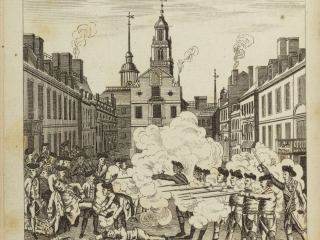
Click here for larger view
The Massacre perpetrated in King Street Boston on March 5th 1770 . . .
anonymous engraving
frontispiece to A Short Narrative of The horrid Massacre in Boston . . .
[Compiled by James Bowdoin, Samuel Pemberton, and Joseph Warren]
London: E. and C. Dilly and J. Almon, 1770
Private Collection
